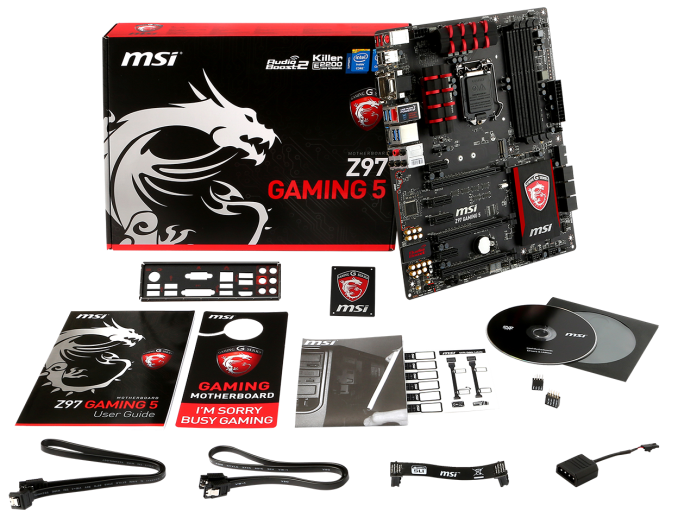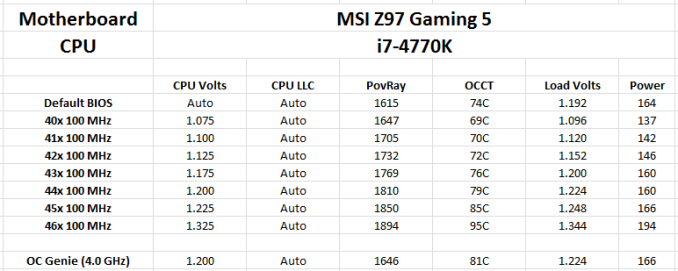MSI Z97 Gaming 5 Motherboard Review: Five is Alive
by Ian Cutress on October 6, 2014 10:00 AM EST- Posted in
- Motherboards
- Intel
- MSI
- Z97
MSI Z97 Gaming 5 In The Box
A gaming branded motherboard has the opportunity of offer a different experience to other motherboard segments. PC Gaming is growing, partially fuelled by popular games and increased resolution sizes driving GPU sales, and MSI’s ‘Gaming’ ecosystem aims to cater for as much as the market as MSI can manage. From the motherboard perspective, aside from the styling, having gaming related box bundles can turn a regular purchase into one that users might suggest to others. The only downside of this is the cost – placing plenty of gaming extras might move the motherboard into a price segment it cannot compete in. At the super high-end, some motherboards get game bundles, but at $148 there is not much room to maneuver.
In the MSI Z97 Gaming 5 we have:
Driver Disk
User Guide
Rear IO Shield
Quick Start Guide
Cable Labels
MSI Gaming Door Hanger
MSI Gaming Series Case Badge
Quick Connectors for the Front Panel
Two SATA Cables
Flexi SLI Bridge
Audio Power Adapter
Here we come across another problem with Gaming motherboard bundles. Features like the door hanger and case badge are interesting to have, but ultimately do not add functionality to the system aside from promoting the use of MSI products. Only having two SATA cables is an oversight – while it caters for an SSD + HDD combination, the minute an ODD is added or a second storage device, more cables are needed.
Many thanks to...
We must thank the following companies for kindly providing hardware for our test bed:
Thank you to OCZ for providing us with PSUs and SSDs.
Thank you to G.Skill for providing us with memory.
Thank you to Corsair for providing us with an AX1200i PSU and a Corsair H80i CLC.
Thank you to MSI for providing us with the NVIDIA GTX 770 Lightning GPUs.
Thank you to Rosewill for providing us with PSUs and RK-9100 keyboards.
Thank you to ASRock for providing us with some IO testing kit.
Thank you to Cooler Master for providing us with Nepton 140XL CLCs.
Test Setup
| Processor | Intel Core i7-4770K ES 4 Cores, 8 Threads, 3.5 GHz (3.9 GHz Turbo) |
| Motherboard | MSI Z97 Gaming 5 |
| Cooling | Cooler Master Nepton 140XL Corsair H80i Thermaltake TRUE Copper |
| Power Supply | OCZ 1250W Gold ZX Series Corsair AX1200i Platinum PSU |
| Memory | G.Skill RipjawsZ 4x4 GB DDR3-1600 9-11-9 Kit |
| Memory Settings | 1600 9-11-9-27 1T tRFC 240 |
| Video Cards | MSI GTX 770 Lightning 2GB (1150/1202 Boost) |
| Video Drivers | NVIDIA Drivers 337 |
| Hard Drive | OCZ Vertex 3 256GB |
| Optical Drive | LG GH22NS50 |
| Case | Open Test Bed |
| Operating System | Windows 7 64-bit SP1 |
| USB 2/3 Testing | OCZ Vertex 3 240GB with SATA->USB Adaptor |
MSI Z97 Gaming 5 Overclocking
Experience with MSI Z97 Gaming 5
MSI’s overclocking regime starts with OC Genie for an easy one-button overclock. Our thoughts on OC Genie have been relatively consistent over the last few generations – offering only one automatic overclock is easy to use but for those users who want a bit more without manual overclocking, it might be a little short sighted.
Manual overclockers should be pleased with MSI’s BIOS adjustment for Z97, giving overclocking options in a nice ordered list compared to a run-on list with no order. The use of Simple/Advanced modes also helps.
In our tests, we found OC Genie on an i7-4770K to come up a little short. It offered a 4.0 GHz overclock, which is only 100 MHz above stock operation. With a multi-stage OC Genie, we might have seen 4.0 – 4.4 GHz for those CPUs that can perform. For manual overclocking, we achieved 4.6 GHz, although it must be noted that the stock voltage was quite high.
Methodology:
Our standard overclocking methodology is as follows. We select the automatic overclock options and test for stability with PovRay and OCCT to simulate high-end workloads. These stability tests aim to catch any immediate causes for memory or CPU errors.
For manual overclocks, based on the information gathered from previous testing, starts off at a nominal voltage and CPU multiplier, and the multiplier is increased until the stability tests are failed. The CPU voltage is increased gradually until the stability tests are passed, and the process repeated until the motherboard reduces the multiplier automatically (due to safety protocol) or the CPU temperature reaches a stupidly high level (100ºC+). Our test bed is not in a case, which should push overclocks higher with fresher (cooler) air.
Overclock Results:
The high voltage at stock lead to a severe drop in power consumption if users are willing to adjust the voltage manually.












45 Comments
View All Comments
Timbrelaine - Monday, October 6, 2014 - link
The many hundreds of dollars they would save?fluxtatic - Tuesday, October 7, 2014 - link
This. For gamers, X99 is an e-peen extender.typographie - Monday, October 6, 2014 - link
DDR4 is actually not a thing in the mainstream market. Probably won't be until Skylake's release, either. We don't need it anyway.spidey81 - Monday, October 6, 2014 - link
There's also talk that initially there will be controller support for both DDR3 and DDR4. Not sure if it is legitimate. It seems unlikely considering it would be extra space on the die used.fluxtatic - Tuesday, October 7, 2014 - link
AMD did it a while back with Phenom II. When my M4A78 board died, I dropped the processor into an M5A97 EVO.That is, AMD might do simultaneous DDR3/DDR4, but I don't think it likely from Intel.
gw74 - Monday, October 6, 2014 - link
"We don't need it anyway" is presumably what you also said about DDR3 when DDR2 was coming to the end of its lifecycle."No one will need more than 637k of memory for a personal computer"
casperes1996 - Monday, October 6, 2014 - link
He obviously meant as in "Right now we don't need it."Not that we'll never need it.
Comparix X99 Haswell-E based systems with the likes of this just isn't fair, and you won't be able to put DDR3 into this.
Nobody in this market needs DDR4 now anyway, n'or will they within the next few years.
gw74 - Monday, October 6, 2014 - link
no he didn't obviously mean anything of the sort, because what do you mean by "need" anyway? just because you don't need the performance today, doesn't mean you shouldn't buy it now to future-proof your purchase.just4U - Wednesday, October 8, 2014 - link
Future proofing sounds good on paper but by the time you actually need to be on something faster chances are you've already moved on to new Hardware perhaps... even several generations on..Nite Owl - Monday, August 24, 2015 - link
No such thing as future proof. What he meant is he isn't dumb enough to squander that kind of cash for very little performance increase. In "real world" bench marking ddr4 doesn't do much. As long as you have good high quality ddr3 your fine. I've been building since 2001. Last years latest and greatest always lasts me at least 3 years, at least. My 2007 build lasted through 2013 with only upgrading the video card, once! Still ran max settings on every game I play. Blind consumers that jump on things for the sake of doing drive up the prices. Nice going, slick!